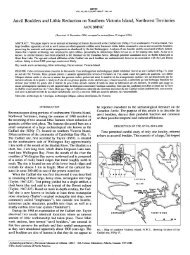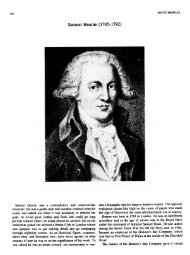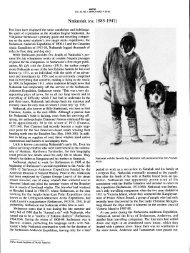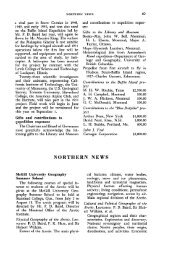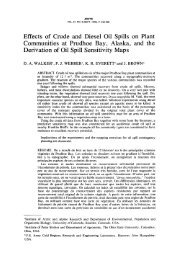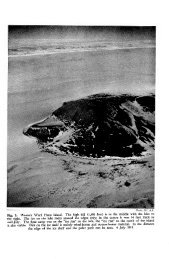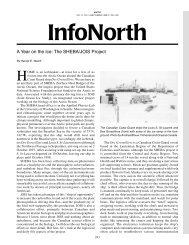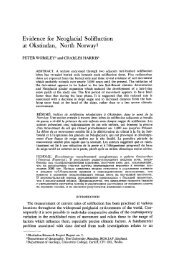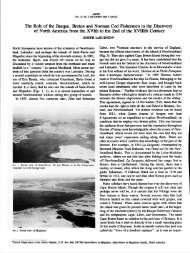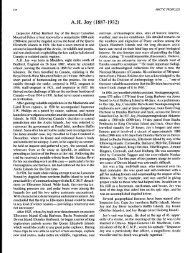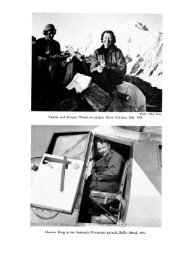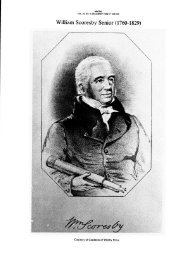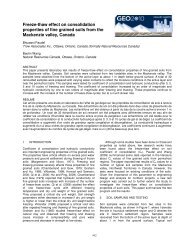NOTES ON THE NUNAMIUT ESKIMO AND MAMMALS OF ... - arctic
NOTES ON THE NUNAMIUT ESKIMO AND MAMMALS OF ... - arctic
NOTES ON THE NUNAMIUT ESKIMO AND MAMMALS OF ... - arctic
Create successful ePaper yourself
Turn your PDF publications into a flip-book with our unique Google optimized e-Paper software.
168 <strong>THE</strong> <strong>NUNAMIUT</strong> <strong>ESKIMO</strong> <strong>AND</strong> <strong>MAMMALS</strong> <strong>OF</strong> <strong>THE</strong> ANAKTUVUK PASS REGI<strong>ON</strong><br />
female cubs, one of which was dark and the other light, were killed with their<br />
mother on 11 July 1951 by the Eskimo on Anaktiktoak Creek1 In Some<br />
animals, head, neck, and shoulders are very pale, sometimes almost buffy-white,<br />
and the legs and belly are dark brown. In the fall the hair is shorter and much<br />
darker, although the dorsal hairs have lighter tips and later become lighter<br />
throughout. Some animals, such as the old bear mentioned above, are very<br />
pale, even in the fall.<br />
The claws of the <strong>arctic</strong> grizzly are long and moderately arched; they range<br />
from dark brown through horn-colour to white. The longest claw of the<br />
fore foot measures from 53 to 77 mm., with an average of 60 to 70 mm.<br />
A good series of skulls, several with skins, has been obtained, and is now<br />
in the collections of the US. National Museum and the National Museum of<br />
Canada. Rather striking variation is seen in some of the skulls, but I attribute<br />
this to normal age and sex differences, and to individual variation. From a<br />
study of other skulls available from this locality, it would seem that skull<br />
growth and changes in skull conformation continue throughout the life of the<br />
animal. The most aged animals examined showed the greatest extremes in<br />
skull measurements. The skulls of these bears have been compared with those<br />
of U. toklat, from which they differ in minor detail. Minor differences were<br />
also observed when these skulls were compared with those of unidentified<br />
bears from Jarvis Creek, in the Biological Survey Collection. The significance<br />
of such differences cannot be determined from the limited material now avail-<br />
able. Table I gives skull measurements for U. richardsoni.<br />
Sex<br />
d<br />
(2-to 3-yr.-old)<br />
d<br />
d<br />
d<br />
d<br />
Condylobasal Zygomatic<br />
length width<br />
266<br />
276<br />
318<br />
318<br />
324.5 219<br />
33 1 223<br />
Palatal<br />
length<br />
155 -<br />
172 154.5<br />
189 163<br />
194 161.6<br />
177<br />
168<br />
(aged)<br />
d<br />
2<br />
d<br />
(old)<br />
?d<br />
d<br />
337<br />
-<br />
339.5<br />
343<br />
358.5<br />
219<br />
-<br />
220<br />
233<br />
177.4<br />
148<br />
177<br />
206 163<br />
181.5<br />
286 174 139<br />
Interorbital<br />
width<br />
60.2<br />
74.4<br />
69<br />
73.6<br />
78<br />
79<br />
82.5<br />
72<br />
78<br />
58<br />
85.5<br />
66<br />
Last<br />
molar<br />
length<br />
Locality<br />
37.8 Canning River<br />
36.4 Tulugak Lake<br />
40 Tulugak Lake<br />
38.5 Tulugak Lake<br />
36 Ikiakpuk Creek<br />
35 Tulugak Lake<br />
36.7<br />
32<br />
35<br />
Tulugak Lake<br />
Alaktak River<br />
Savioyok Creek<br />
36.5<br />
36<br />
33<br />
Tulugak Lake<br />
Savioyok Creek<br />
Tulugak Lake<br />
Table I. Skull measurements of 12 specimens of Ursus richurdsoni (in millimetres).<br />
The skull of a cub, killed on 23 September 1948, allows the following<br />
observations on the rate of irruption of the permanent dentition:<br />
The permanent first upper incisors are in place, and the second incisors are just<br />
emerging. The deciduous third incisors are still present, although the points of the<br />
permanent teeth are visible. The deciduous canines are still in place, but the<br />
permanent canines can be seen coming through anterior to them. On the right side,<br />
two premolars are present, and on the left there are three. The first upper molar is in<br />
1The skins of these cubs have been deposited in the US. National Museum.



